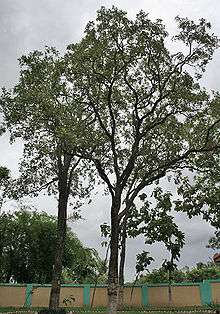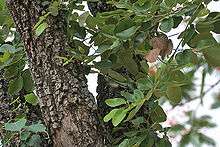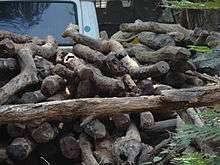Pterocarpus santalinus
Pterocarpus santalinus, with the common names red sanders, red saunders, red sandalwood, Rakt Chandan, and saunderswood, is a species of Pterocarpus endemic to the southern Eastern Ghats mountain range of South India.[1][3] This tree is valued for the rich red colour of its wood. The wood is not aromatic. The tree is not to be confused with the aromatic Santalum sandalwood trees that grow natively in South India.
| Pterocarpus santalinus | |
|---|---|
 | |
| in Talakona forest, in Chittoor District of Andhra Pradesh, India. | |
| Scientific classification | |
| Kingdom: | |
| (unranked): | |
| (unranked): | |
| (unranked): | |
| Order: | |
| Family: | |
| Subfamily: | |
| Tribe: | |
| Genus: | |
| Species: | P. santalinus |
| Binomial name | |
| Pterocarpus santalinus L.f. | |
| Synonyms[2] | |
| |
Description


Pterocarpus santalinus is a light-demanding small tree, growing to 8 metres (26 ft) tall with a trunk 50–150 cm diameter. It is fast-growing when young, reaching 5 metres (16 ft) tall in three years, even on degraded soils. It is not frost tolerant, being killed by temperatures of −1 °C.
The leaves are alternate, 3–9 cm long, trifoliate with three leaflets.
The flowers are produced in short racemes. The fruit is a pod 6–9 cm long containing one or two seeds.[4][5]
Uses
Timber
The wood has historically been valued in China, particularly during the Qing Dynasty periods, and is referred to in Chinese as zitan (紫檀) and spelt tzu-t'an by earlier western authors such as Gustav Ecke, who introduced classical Chinese hardwood furniture to the west.[6] An exquisite chair made of red sandalwood can be seen today in China's Forbidden City in Beijing, inside the Hall of Supreme Harmony, and once used by the emperors of the Qing Dynasty.
Due to its slow growth and rarity, furniture made from zitan is difficult to find and can be expensive.[7] It has been one of the most prized woods for millennia.
In India sandalwood is one main and lucrative market for smugglers, as a high price is paid for this wood in China. Since the exporting of sandalwood is illegal in India, the underground market is growing and there are a number of arrests every year of those trying to smuggle this wood to China.
The other form of zitan is from the species Dalbergia luovelii, Dalbergia maritima, and Dalbergia normandi, all similar species named in trade as bois de rose or violet rosewood which when cut are bright crimson purple changing to dark purple again. It has a fragrant scent when worked.[6]
Shamisen
Red sandalwood has been used for making the bridge and also the neck of the Japanese musical instrument Shamisen.[8] It has great demand for the heartwood
Medicinal values
Pterocarpus santalinus is used in traditional herbal medicine as an antipyretic, anti-inflammatory, anthelmintic, tonic, hemorrhage, dysentery, aphrodisiac, anti-hyperglycaemic and diaphoretic.[9][10]
Grading of red sandalwood

Red sandalwood grown on the shale subsoils, at altitudes around 750 metres (2,460 ft), and in semi-arid climatic conditions gives a distinctive wavy grain margin. Lumber pieces with the wavy grain margin are graded as "A" grade. Red sandalwood with wavy grain margins sells at higher prices than the standard wood.
Conservation status
Pterocarpus santalinus was listed as an Endangered species by the IUCN, because of overexploitation for its timber in South India; however, it was later reclassified to Near Threatened in 2018, as the scale of this loss is not properly known.[11] It is also listed in the appendix II of the CITES, which means that a certificate is required in order to export it, that should only be granted if the trade is not detrimental to the survival of the species.[12]
More Pictures
 Pterocarpus santalinus (Red Sandal) Leaves. Kerala, India
Pterocarpus santalinus (Red Sandal) Leaves. Kerala, India Pterocarpus santalinus (Red Sandal) Leaves. Kerala, India
Pterocarpus santalinus (Red Sandal) Leaves. Kerala, India Pterocarpus santalinus (Red Sandal) Leaves. Kerala, India
Pterocarpus santalinus (Red Sandal) Leaves. Kerala, India Pterocarpus santalinus (Red Sandal) New Shoots Pink Colour. Kerala, India
Pterocarpus santalinus (Red Sandal) New Shoots Pink Colour. Kerala, India Pterocarpus santalinus (Red Sandal) New Shoots Pink Colour. Kerala, India
Pterocarpus santalinus (Red Sandal) New Shoots Pink Colour. Kerala, India_red_sandalwood_tree_at_IG_Zoo_Park_in_Visakhapatnam_03.jpg) Pterocarpus santalinus (Red Sandal) at North coastal Andhra
Pterocarpus santalinus (Red Sandal) at North coastal Andhra
See also
References
- IUCN Report: Pterocarpus santalinus (Almug, Red Sandalwood, Saunderswood)
- "The Plant List: A Working List of All Plant Species". Retrieved 30 September 2014.
- International Legume Database & Information Service: Pterocarpus santalinus
- FAO Ecocrop: Pterocarpus santalinus
- Auroville: Wasteland reclamation through rehabilitation of eroded soil (pdf file) Archived 2007-06-23 at the Wayback Machine
- http://www.chinese-furniture.com/cgi-bin/ccf.cgi?stt=stp&pgn=newsletter_archive/newsletter_2.html&id= Chinese Furniture.com newsletter; Volume 1, Number 2; Accessed 2007-04-05
- http://www.wctg.net/zitan.html Archived 2007-05-18 at the Wayback Machine; Accessed 2007-04-06
- , Japanese Music and Musical Instruments
- http://shodhganga.inflibnet.ac.in:8080/jspui/bitstream/10603/37317/9/09_chapter%203.pdf
- "Pterocarpus santalinus Linn. f. (Rath handun): A review of its botany, uses, phytochemistry and pharmacology". Journal of the Korean Society for Applied Biological Chemistry. 54 (4): 495–500. August 2011. doi:10.3839/jksabc.
- Red List of Threatened Species: Pterocarpus santalinus, IUCN
- Appendices I, II and III, CITES
External links
| Wikimedia Commons has media related to Pterocarpus santalinus. |
